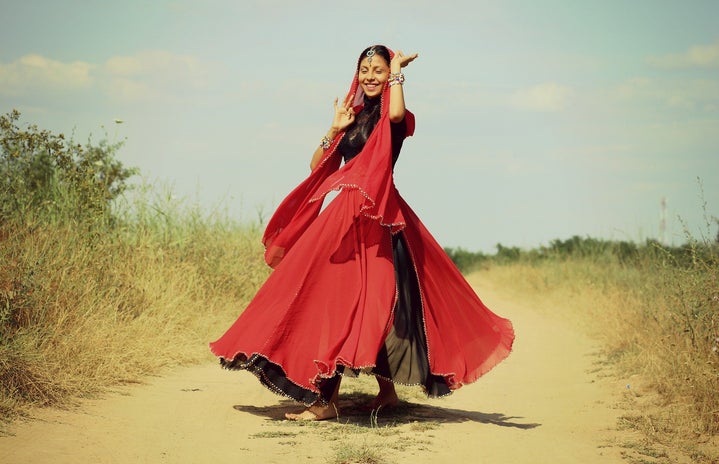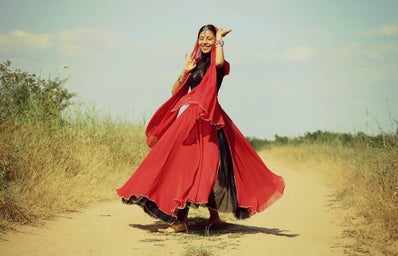For those who don’t know, the term “Bollywood” refers to the Indian genre of cinema and film, derived from the words “Hollywood” and “Bombay”. As an Indian myself, I grew up watching all kinds of Bollywood classics, and needless to say, I knew what standards were before they were even a thing. Bollywood likes to cater to a lot of audiences, from the hopeless romantics to the ancient history fanatics. But the reason the genre itself has its own name is because of its distinct qualities that set it apart from things like K-dramas and anime. The majority of our music comes from our films, and our stories reflect the richness of our culture as it changes throughout the years. Granted I could be exaggerating my love for these films since there are a ton of cultural references that one may not understand as a non-Indian. However, that is what I’m here for! If you are someone looking to start watching Bollywood films (which I highly encourage), then let me tell you everything you need to know, and even give you a few recommendations of my own so that you can get started on your Bollywood journey.
If they start singing, don’t question it
If you ever look up a Bollywood movie on Google, oftentimes they are categorized as musicals. The reason for this is because almost all of our films have music in them, meaning at some point, someone will break out into song for a dance number. This is separate from what is usually considered a musical in Western cinema since the main story isn’t told through song, they act as small catalysts to the storyline. No, the actors themselves are not singing, and no, this isn’t always part of the plot. However, this is why Indians usually have a different playlist for their songs aside from Western songs, because the songs we listen to come from the movies we watch! So, whenever I want to find an Indian song, I usually ask my Indian friends, “What movie is that from?” instead of “Who sang that song?” or “What album is that from?” The songs in Bollywood films are usually either very upbeat, super romantic, or insanely depressing; there’s no in between. These songs are also the reason why Bollywood movies tend to be very long, ranging from two and a half to four hours. Bollywood likes to reuse a lot of notable people in the industry, actors and musicians alike, so you’ll hear some familiar voices like Shreya Goshal and Arjit Singh. Unironically, Bollywood managed to get the singer Akon on an iconic song called Chammak Challo, which is how I found out who he was in the first place. Despite that, I’ve always had a sense of pride in the idea that we were practically the only people who consistently put songs in movies as a supporting element, so you can imagine my thoughts when I saw the iconic dance scene in Barbie to “Dance the Night Away” by Dua Lipa. Additionally, we pretty much get all of our dances from Bollywood movies as well, so whenever people dance at Indian weddings, they usually take some bits and pieces from the original choreography of the song and put their own spin on it. But if you are one of those people that like to dance at 3 a.m., then Bollywood music is definitely the right fit for you.
Jai hind
Bollywood sometimes has a habit of making movies that are extremely patriotic, and usually the main antagonist is the Pakistani government or the British. For those who don’t know, India and Pakistan have had a rocky relationship ever since Partition in 1947, which segregated the Hindu and Muslim majorities who struggle to coexist to this day. For this reason, there is an entire Bollywood genre dedicated to Indian patriotism, which usually consist of epic fictional stories from RAW, or India’s foreign intelligence agency. In fact, there’s an entire cinematic universe consisting of 5 different movies, 3 of which are a series pertaining to a RAW agent who falls in love with an ISI agent (Ek Tha Tiger), which is Pakistan’s foreign intelligence equivalent and RAW’s supposed rival. Sometimes these stories like to explore the possibility of peaceful relations between the two countries, which are told from the perspectives of seemingly ordinary people rather than government agents. Only recently has Bollywood begun to shift towards criticizing corruption within Indian government systems, such as unfair loans and unreasonable politicians. But aside from that, we usually resort to attacking British occupation, most notably in movies like RRR (where the Oscar winning song “Natu Natu” came from) and Lagaan, an epic story about a group of villagers driving out the British with a cricket match. Personally, I’ve grown to find the action in these films a little cringy, but they can be fun to watch.
The original romantics
One of the things I’ve grown to appreciate about Bollywood is how they portray romance. In films from the early 2000s (which I personally consider to be the golden age), romance wasn’t defined by a spicy scene or even a kiss; it was just the little things. One of the movies that I like to call “the blueprint” of Bollywood is called Dilwale Dulhania Le Jayenge which has a scene where the male lead has to leave because the girl’s father disapproves of their relationship. As he’s leaving on a train, he watches the father on the platform holding onto the girl’s arm, preventing her from running after him. That was until at the last minute, the father lets go and tells her to live her life. Elated, she runs after her love and he holds out his hand to her so that they can get on the train together and live happily ever after. I’d say that romance is one of Bollywood’s most creative genres, and it is beyond perfect for the hopeless romantics. Hindus believe in the idea of reincarnation, which is being born again into a different life after death, and there is an amazing movie called Om Shanti Om that pays homage to the Bollywood industry while unraveling a love story that transcends lifetimes. Bollywood also deals with emotional maturity in movies like Yeh Jawaani He Deewaani, where he chooses to give up his life’s dream in order to be with her. Then there’s times where he knows he doesn’t have much time left, so he has her fall in love with someone else so that she’ll be happy even though he has to let her go (Kal Ho Naa Ho). And this is just scratching the surface, but usually the romance is a subplot to the main storyline, which for some reason is almost always a revenge story. For example, a movie called Happy New Year features a group of losers joining together to pull off a diamond heist and take down the murderer of the main character’s father…through a dance championship? There are even more modern films that deal with repairing friendships through a bachelor’s trip to Spain in Zindagi Na Milegi Dobara, and a deeper dive into the patriarchal structure of Indian families hindering the dreams of the youth in Dil Dhadakne Do. Overall, Bollywood has created a completely different set of standards for romance in film, and I’ve appreciated the fact that it has always been contingent on the little interactions that get me emotionally invested in the chemistry rather than the nitty gritty (which is also great for my aro-ace heart).
The cultural jargon
Though Bollywood tends to reference other more iconic movies within movies, there are also a slew of cultural references that one might not understand as a person of non-Indian origin. This largely translates to wedding culture, for some reason, as well as some larger references to Hinduism. The first is the sindoor (hindi for vermillion), which is essentially a red powder that women wear on the space where the middle part begins on the forehead. This signifies that a woman is married, and is usually worn every day, similar to a wedding ring. Another indicator of marriage is the mangalsutra, which is a gold necklace lined with dark beads that a wife typically wears. Additionally, there is also a wedding tradition where the bride and the groom tie their dupattas (Indian scarves) together and walk around a fire 7 times, which signifies that they will be together for 7 lifetimes. The bride wears red for weddings, and everyone wears white for funerals. The deceased are usually burned in a bonfire, and their ashes are sometimes held in an urn. Usually if a scene cuts to a metal pot with a red cloth on top or a huge bonfire with a bunch of people wearing white standing behind it, it means someone died. It is also sometimes tradition to release these ashes into one of India’s sacred rivers, usually Yamuna and Ganga. If there’s a picture frame in the background with a garland, it means that the person in the picture has died. Finally, the two main festivals that you should know are Diwale and Holi. Diwale is the festival of lights, which usually involves a bunch of firecrackers, tiny pots with candles in water, and other holy ceremonies. Holi is the festival of colors, which involves people dressed in white (not for funerals) and throwing brightly colored cornstarch powder at each other. Then of course there’s the patriarchy, where there are old ideals of women having to give up their jobs and their dreams to provide for their home, as well as sons catering to their father’s desires rather than listening to their hearts. And there is also the idea of arranged marriage, which is not the same thing as a forced marriage and is when two people are usually set up between families and are set to marry each other (this was very common in the older generation).
My recommendations
In addition to those already mentioned, here are what I consider to be films that are both beginner friendly and cinematic masterpieces.
- Band Baaja Bharat: Two people become partners out of college in order to run a wedding planning organization, but despite their promise to stay friends, one ends up falling for the other, causing the entire operation to fall apart.
- Chennai Express: After a series of mishaps trying to fulfill his grandfather’s last wish, Rahul lets the wrong person onto the train and sets off on a journey where he ends up having to fight to prove himself worthy of her love.
- Rab Ne Banadi Jodi: A student finds himself quietly falling in love with his teacher’s daughter on her wedding day, but when her fiancé unexpectedly dies, he finds himself married to her instead through her father’s last wish. Now they must find a way to live with each other even though he still loves her and she must move on from her last love.
- Dhoom (series): I wouldn’t recommend the first one, but this is an action series where a cop is trying to catch a criminal who is played by a notable actor each time, and their story always contains a fun twist (the second one is the best).
- Bajirao Mastani: A historical retelling of a Brahman king who falls for someone who is half-Hindu half-Muslim, and the adversities they face together.
- Padmavati: A dramatic historical depiction of the most beautiful woman in the world, Padmavati, and the Mughal ruler, Alauddin, who wanted all things precious in the world and does everything he can to have her (this isn’t romantic).
- Kuch Kuch Hota Hai: A girl has letters she opens from her deceased mother on her birthday, and on one particular birthday, her mom tells her the story of who she was named after – her dad’s college best friend. Once she hears the whole story, she sets on a mission to fulfill her mom’s last wish – to get them together again.
Though there’s quite a bit to know, I genuinely think Bollywood is one of the best film genres out there and should get a lot more global recognition. The majority of these films are available on Netflix, while some are on Amazon with prime. I know that I’m a person who is always in need of something new to watch and sometimes to feel nostalgic. So, I go back to some of these films and look at them from a much older perspective, which leads me to finding new things. But for those who are getting tired of K-dramas and aren’t feeling any of the new Netflix originals, then I urge you to give Bollywood a try. Who knows? You might just find what you’ve been looking for.


